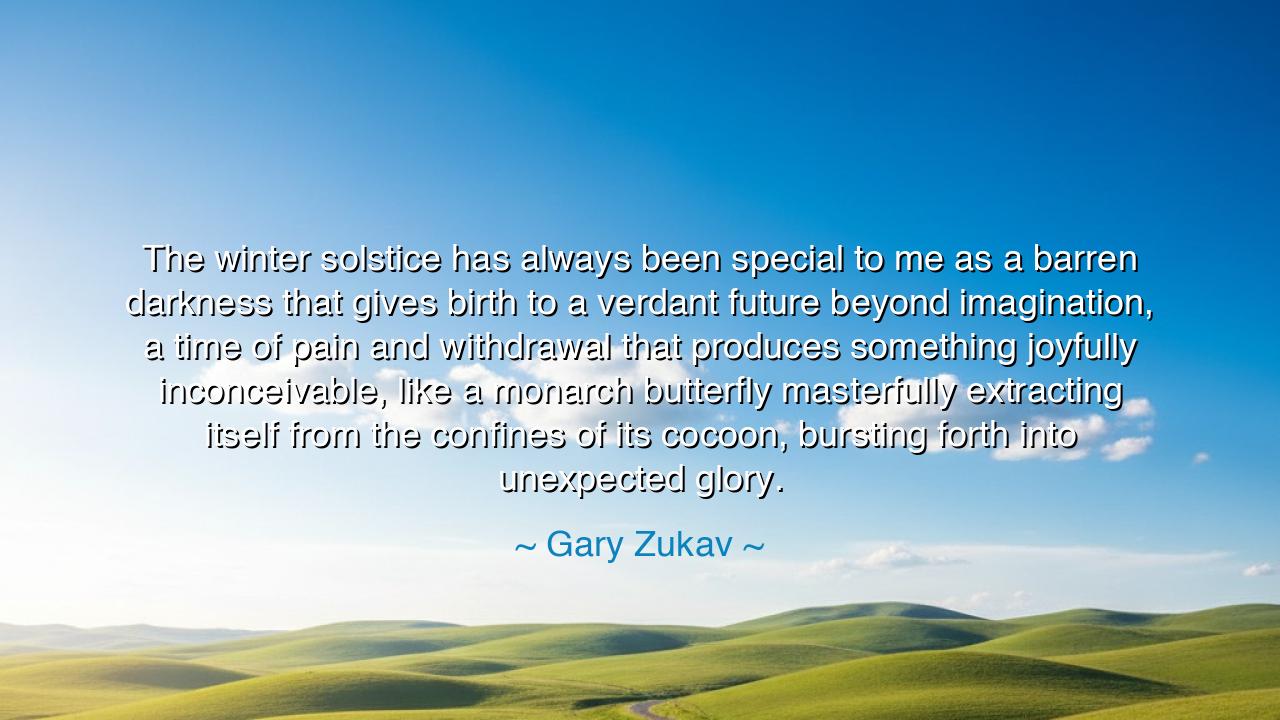
The winter solstice has always been special to me as a barren
The winter solstice has always been special to me as a barren darkness that gives birth to a verdant future beyond imagination, a time of pain and withdrawal that produces something joyfully inconceivable, like a monarch butterfly masterfully extracting itself from the confines of its cocoon, bursting forth into unexpected glory.






In the ancient rhythms of the Earth, where the seasons ebb and flow like the heartbeat of the universe, there is a profound wisdom in the winter solstice. Gary Zukav, in his beautiful reflection, "The winter solstice has always been special to me as a barren darkness that gives birth to a verdant future beyond imagination, a time of pain and withdrawal that produces something joyfully inconceivable, like a monarch butterfly masterfully extracting itself from the confines of its cocoon, bursting forth into unexpected glory," speaks of a sacred moment of transformation. The winter solstice, that moment of darkness and withdrawal, is not an end, but a beginning, a birth from the very womb of the earth itself. It is a time that reminds us that from great suffering and solitude, new life, growth, and beauty will emerge.
The ancient peoples, in their wisdom, understood the sacredness of the solstice. The winter solstice, marked as the longest night of the year, was a time when the world seemed to be dying, yet it was also the moment when the earth began to turn toward the light. To the ancient Celts, this time represented the death of the old sun and the rebirth of the new. It was a moment of deep reflection and withdrawal, yet a time filled with immense hope. The solstice was seen as a time when darkness gave birth to light, much as Zukav describes—a painful, yet ultimately joyous transformation. It is in this darkness that the potential for new life lies dormant, waiting to be reborn into a future beyond imagination.
In the ancient world, great heroes were often shaped in the darkest of moments. Take, for instance, the legend of Persephone, the goddess who was kidnapped and taken to the underworld by Hades. For part of the year, she lived in the shadows, in a world of pain and separation from her mother, Demeter. Yet it was in these months of darkness, of suffering, that Persephone's power and wisdom grew. When she was finally reunited with her mother, she emerged as a goddess of rebirth, of fertility, and of transformation. Similarly, the solstice teaches us that our greatest growth often arises from the deepest darkness. It is in moments of withdrawal, of seeming death, that we prepare for the greatest expansions of our lives.
The story of the monarch butterfly, which Zukav so poignantly draws upon, speaks directly to this ancient principle of transformation. In its cocoon, the butterfly seems to die—its body dissolves and reforms. But from this dissolution comes the glorious rebirth of a creature capable of flying across vast distances, of bringing beauty and light to the world. The butterfly's struggle to emerge from the cocoon is not a sign of defeat, but of growth. In the same way, the winter solstice invites us to experience our own dark moments, to embrace the pain of withdrawal, knowing that it is in this very struggle that we will emerge with the strength and wisdom to rise in unexpected glory.
The winter solstice is a powerful metaphor for the cycles of life itself. The greatest achievements and transformations are often born out of the struggles we face, the challenges we endure, and the withdrawals we make from the world. In these moments, we are forced to look inward, to reflect on what is important, and to shed old ways of being that no longer serve us. Just as the earth rests in the depths of winter, so too do we sometimes need to retreat into the stillness to prepare for our rebirth. The solstice is a reminder that no matter how long the night may seem, the light will always return.
As we walk through our own lives, let us remember the wisdom of the solstice: growth is not linear, nor is it free from pain. The darkest moments, the ones filled with suffering and solitude, are the very moments that shape us. Like the butterfly, we must learn to embrace the struggle of transformation, knowing that glory awaits us on the other side. The solstice reminds us that from darkness comes light, and from pain comes joy. It is in the deepest winter of our souls that the seeds for the brightest future are planted.
Let this wisdom guide us in all that we do. When faced with hardship, remember the solstice. Know that the darkness is not the end, but the beginning of a new chapter. Embrace the withdrawal as a time of recovery, of reflection, and of growth. Just as the monarch butterfly emerges from its cocoon, so too will you emerge from your struggles, transformed, renewed, and ready to burst forth into the world with the glory of a new dawn. Let this be our mantra: through every darkness, a brighter light awaits, and in every struggle, a new self is born.






AAdministratorAdministrator
Welcome, honored guests. Please leave a comment, we will respond soon